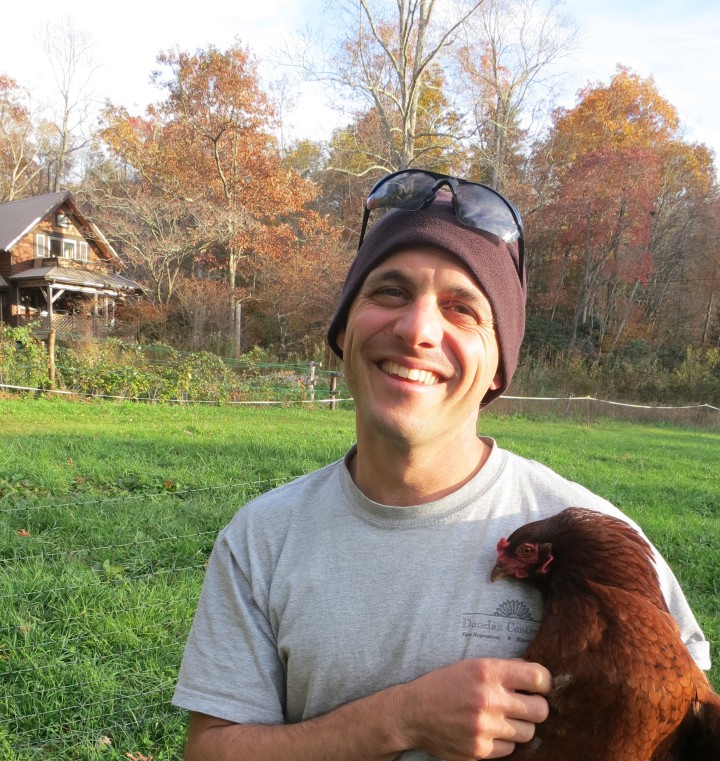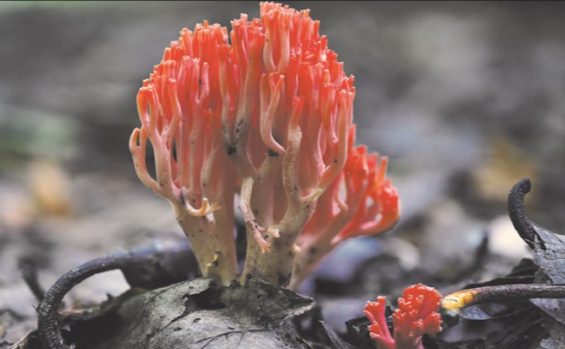BY TAL GALTON
During their evanescent fruiting period, native forest fungi demand our attention. Peak season is July to September, and after only a few days, most mushrooms either dry out, turn to mush in the rain or get picked apart by critters. No Western North Carolina hiker can walk in the woods in the wake of an August downpour without noticing dozens of mushrooms that transform the forest into a sculpture garden overflowing with colorful, exotic forms. White puffballs, red and orange chanterelles, pink and purple coral mushrooms, bulbous boletes, bright yellow and ghostly white amanitas are just a few examples of the many specimens adorning the forest floor.
But these “fruiting bodies” are really just the reproductive tip of the living organism, temporarily protruding from the ground. A common analogy is that if a fungus were an apple tree, only the flowers and fruit would be visible to us, with the rest of the tree’s structure hiding underground. The trouble with this metaphor is that fungi are not plants and indeed are nothing like them: On the tree of life, fungi are actually more closely related to animals.
Catching carbon

Plants are our planet’s great autotrophs: living things capable of harvesting energy directly from the sun. The rest of us are heterotrophs. Whether it’s a person eating a hamburger, a Hickory Nut Gap cow grazing on grass, or the threadlike hyphae of a chanterelle sipping sap from an oak root, we’re consumers, mooching carbon originally sequestered by plants.
But for all the botanical diversity these mountains are renowned for, there are roughly twice as many known species of local fungi as there are plants. In the Smokies alone, over 3,500 species of fungi have been observed. Participants in my mushroom walks are astonished by the array we can gather in an hour or two. A half-day foray with experts from the Asheville Mushroom Club may turn up well over 100 species. And in just four days of roaming the woods around Hendersonville last August, the more than 400 professional and amateur mycologists attending Appalachia NAMA identified over 500 unique species. Organized by the North American Mycological Association, the annual gathering rotates around the continent and, despite unseasonably dry conditions, the 2023 event broke the organization’s species count record, due in part to both strong attendance and Western North Carolina’s status as a hot spot for fungal diversity.
Hide and seek
Like almost all of our native plants, local fungi are perennial forest dwellers, but for most of the year, their entire biological structure is hidden from view. Woody trees and shrubs are visible year-round; many herbaceous plants are aboveground for six to eight months; true spring ephemerals display for maybe six weeks. Many fungi, though, show themselves for only a few days.
Fungi span a remarkably diverse and adaptable kingdom. Some are decomposers: They feed on dead organic matter and are exceptionally good at breaking down lignin and cellulose. These play an essential role in the ecosystem, turning hard-to-digest plant fibers into palatable nutrients for the forest’s food web.
But some of the most charismatic local fungi (including most chanterelles, boletes and amanitas), pursue a different strategy, connecting with living plant roots, trading carbohydrates for minerals — and perhaps even facilitating interspecies communication. The science behind those networks, colloquially known as the wood wide web, is in its infancy and still hotly debated: As with many forest species (and the incredibly complex systems they compose), there is far more that we don’t know about mushrooms than there is that we know (or think we do).
For most of the year, forest fungi discreetly go about their business. By late summer, the trees and their green, leafy co-workers have spent months gathering sunlight and pumping carbon-based energy into the forest system. And when the energy level reaches its peak, the forest floor erupts with mushrooms. This is the reproductive stage. Fungi have unique and very, very complicated sex lives. But at the most basic level, fungi propagate via spores — minuscule nuggets of genetic material — both sexually and asexually.
Spreading it around
A mushroom is simply a fungus’s spore-dispersal mechanism, one of hundreds of creative strategies fungi have developed for scattering their millions of spores. Puffballs spout spores through an orifice. Bird’s-nest fungi release them when raindrops splash into their cups.
Many mushrooms rely on gills which, like wrinkles in our brains or villi in our intestines, exponentially increase the surface area. In the gills’ case, that expands the opportunities for spore formation, while simultaneously providing optimal conditions for ejecting them into the air. Fungi have evolved gills several different times across separate lineages in a classic example of convergent evolution: different branches of the tree of life converging upon the same elegant architectural solution to a problem.
Some mushroom geeks with a dark sense of humor like to say that every mushroom is edible … once. I like to say every mushroom is edible … by something. Many shrooms enlist insects and other animals (humans included) to help spread spores. Stinkhorns smell like carrion and thus attract flies and beetles. Some mushrooms that are toxic to humans are relished by the likes of snails and slugs.
If you closely examine almost any wild mushroom, you will likely find it covered with fruit flies, little fungus gnats or tiny springtails. Some mushrooms, or their mycelia, glow in the dark, displaying “fox fire” (perhaps derived from the Frenglish phrase “faux fire”). This bioluminescence presumably evolved to attract nocturnal insects, but it works with humans too. On a night walk, few things garner as many “Aahs!” as a bright cluster of luminescent Panellus.
A walk on the wild side
Many eager mushroom hunters are initially seduced via their taste buds. But besides enticing flavor compounds, otherworldly forms and myriad colors — not to mention those few species that produce chemicals capable of altering human minds — these evolutionary masterworks capture our attention from as many different angles as there are ways to fling spores into the air. Opening your eyes to the astonishing world of forest mushrooms will introduce you to a subtle but powerful thrill. Like hunting, bird-watching or wildflower pilgrimages, a mushroom foray is a deluxe forest bath. You get the meditative experience of walking in the woods combined with the intense and ancient practice of carefully searching for and identifying diverse natural wonders.
Yancey County resident Tal Galton is a naturalist who loves introducing people to wild places. He runs Snakeroot Ecotours.




I would like to reply to commend you for publishing the article by Tal Galton on Mushrooms. I learned a lot!
I belonged to a Mushroom Club in Sunapee NH for a number of years. We hunted Shrooms weekly during the summer.
It also was a club of experts and learners. Great fun to hunt, identify and cook the same day.
Your Mountain Express is much appreciated. I will contribute so we can sustain the excellent journalism you offer.
THANK YOU! Charlotte Brook-Signor